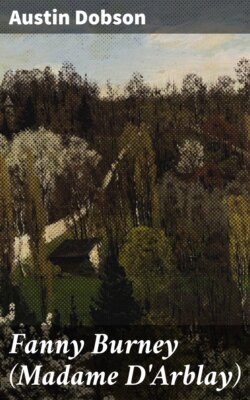Fanny Burney (Madame D'Arblay)

Реклама. ООО «ЛитРес», ИНН: 7719571260.
Оглавление
Dobson Austin. Fanny Burney (Madame D'Arblay)
Fanny Burney (Madame D'Arblay)
Table of Contents
PREFACE
CHAPTER I. THE BURNEY FAMILY
CHAPTER II. NO. 1, ST. MARTIN’S STREET
CHAPTER III. THE STORY OF EVELINA
CHAPTER IV. THE SUCCESSFUL AUTHOR
CHAPTER V. CECILIA—AND AFTER
CHAPTER VI. THE QUEEN’S DRESSER
CHAPTER VII. HALF A LIFETIME
INDEX
Отрывок из книги
Austin Dobson
Published by Good Press, 2021
.....
At this date, he was four and thirty. He set up his tent in Poland Street, then a rather more favoured place of residence than it is at present, and having, beyond the Oxford Road (as Oxford Street was then called), little but open fields and market gardens. Portman Square, Manchester Square, Russell Square,—of all these not a stone had been laid.[2] But Poland Street was not without aristocratic occupants. The Duke of Chandos, Sir Willoughby Aston (with whose daughters the Miss Burneys went to school at Paris), Lady Augusta Bridges and others were all distinguished neighbours in this now dingy street—to say nothing of the Cherokee King, who, when he visited England, actually, to the delight of the Burney children, took lodgings “almost immediately opposite.” At Poland Street Charles Burney rapidly became the music master most in request with the fashionable world. Soon he had not an hour of the day unoccupied, beginning his rounds as early as seven in the morning, and finishing them, sometimes, only at eleven at night. Often he dined in a hackney coach on the contents of a sandwich box and a flask of sherry and water. But he must still have found time for original work, since it was at Poland Street that, besides “Sonatas for the Harpsichord,” he composed in 1763 the setting for Bonnell Thornton’s Burlesque Ode on St. Caecilia’s Day, “adapted to the Antient British Musick; viz.: the Salt Box, the Jew’s Harp, the Marrow-Bones and Cleavers, the Hum-Strum or Hurdy-Gurdy,” and the rest, which was performed at Ranelagh in masks, to the huge delectation of an audience musical and unmusical, and the amusement of Dr. Johnson.[3] But the pleasures of increasing popularity were dashed by domestic misfortune. Mrs. Burney, the “pretty mate” of the last paragraph, having, in the new home, given birth to a fourth daughter, Charlotte, sickened of consumption. A visit to the Bristol Hot Wells (Clifton) proved unavailing; and to the intense grief of her husband and family, she died, after a brief illness, on the 28th September, 1761. She seems to have been a most affectionate mother, and sympathised with her husband in his bookish tastes. With one of his subsequent essays he published a translation from Maupertuis, which she, naturally an excellent French scholar, had executed; and her reading of Pope’s Works and the Virgil of Spence’s friend Christopher Pitt, was one of the memories of her daughters. But at the time of her death her eldest child was only twelve, and her youngest a baby.
The little family at Poland Street, thus suddenly left motherless, must have been an exceptionally interesting one. Esther, or Hetty, the eldest, is described as extremely beautiful, and possessed of that fortunate combination, good sense, good humour, and an abundant love of fun. She was besides remarkably musical, and according to the Gentleman’s Magazine, was wont to astonish her father’s guests, at a very early age, by her skilful instrumentalism. James, the eldest son, who, at the age of ten, entered the Navy under Admiral Montagu as a nominal midshipman, was an unusually bright and manly lad, full of vivacity and high spirits. When at school in his Norfolk home, he had been taught by Eugene Aram. He could recall how that “melancholy man” would pace the playground talking of strange deeds to the elder boys; and he remembered well the memorable night in August 1758 when
.....